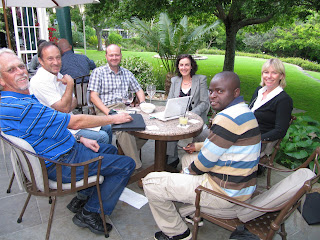Monday November 14th
Flotation '11 is by far the largest MEI Conference on record, with over
280 delegates representing 29 countries. This morning I welcomed the 247 delegates who will be attending the first two days, the Fundamentals Symposium, after which our consultant in this area,
Prof. Dee Bradshaw of the JKMRC, Australia opened the event (see posting of
13th November for full details).
 |
| Me, Jim Finch and Dee Bradshaw |
The keynote lecture,
Bubbles and Flotation, was given by
Prof. Jim Finch, of McGill University, Canada, who highlighted that flotation may be the largest industrial application of adsorptive bubble techniques. The production and distribution of bubbles is central to plant operation but has not received as much attention from researchers as, say, the control over particle properties. The situation is changing as new measurement tools become available. The presentation summarised three areas of research into bubbles as related to flotation processes: determining frother structure-property relationships the example being the link between critical coalescence concentration (CCC) and the hydrophilic-lipophilic balance (HLB); the origin of bi-modal distributions in the absence of frother using a combination of high-speed imaging and acoustic emission; and the link between particle recovery, gas holdup and ionic strength in the case of inorganic salts.
 |
Morning chairmen Andreas Fredrikkson
and Juan Yianatos |
The bubbles and flotation theme continued in the morning session with papers from Finland, USA, Canada, Australia, South Africa. These included the first of the 13 papers at the conference co-authored by researchers from Australia's JKMRC/JKTech, who are represented by 12 delegates, as well as being major sponsors and exhibitors.
There are a number of young people making their conference presentation debuts at the conference, and I managed to get some of them together this morning for a photo (below), which I hope I may be able to embarass them with in a few years time!
 |
| With Silas Hundi |
Silas Hundi is our first ever delegate from Eritrea. He is representing Nevsun Resources, a growing high grade, low cost gold producer focused on its Bisha Mine in Eritrea, East Africa. Bisha is a large precious and base metal volcanogenic massive sulphide deposit that went into commercial gold-silver production in February 2011. It is expected to produce more than 1.14 million ounces of gold, 11.9 million ounces of silver, 821 million pounds of copper, and over 1 billion pounds of zinc during its initially estimated 13 year mine life. In 2013, the processing plant will be expanded, with transition into low cost copper, gold, and silver production.
 |
Afternoon chairmen David Verrelli
and Pablo Brito-Parada |
The University of Cape Town is just a short drive from the conference hotel, so it is not surprising that their strong mineral flotation group is represented by 19 delegates and they presented the first of the 16 papers with UCT co-authors this afternoon.
Surface chemistry and water quality and usage were the main themes of the long afternoon session, which included an interesting paper on improving the flotation of diamonds, from
Mike Rylatt of Sepro Mineral Systems, Canada (see blog of
29 September). This paper is co-authored by
Roe-Hoan Yoon of Virginia Tech, USA, who, like this morning's keynote speaker,
Jim Finch, is a past recipient of the prestigious
Gaudin Gold Medal Award. The Virginia Tech group has co-authored 6 papers in the conference.
It has been a long, but interesting, 10 hour day, and at the end of it, welcome relaxation in the hotel bar and swimming pool.
Tuesday November 15th
 |
Morning chairpersons Graeme Jameson
and Belinda McFadzean |
An eclectic mix of papers this morning, including presentations on CFD modelling and positron emission particle tracking by the impressive team from Imperial College, the premier mineral processing research group in the UK. The team of seven, led by
Prof. Jan Cilliers, will be presenting 8 papers over the next four days.
A popular innovation this year has been the Satellite Room, where delegates can sit and work while listening to the presentations, transmitted from the main confence room with the visual displays.
 |
Afternoon chairs, Natalie Shackleton
and Norman Lotter |
Reagents were the main topics in the afternoon session, with interesting papers from Australia and Japan on the treatment of refractory ores (see also blog of
10th September). I was particuarly interested in two papers from
Greg Hope's team at Griffith University, Australia, on the flotation of chrysocolla and malachite using hydroxamate reagents. During my time at Nchanga in the early 70s, the world's largest copper solvent extraction plant was built solely on the inability of the flotation plant to recover chrysocolla, cuprite and pseudomalachite.
Despite the beautiful weather, the confence centre has been buzzing today and the long morning coffee and lunch breaks gave plenty of time for poster and exhibition viewing, as well as for informal mini-meetings. I met with
Dean Eastbury of Elsevier, to discuss the progress of
Minerals Engineering journal, which will be reported in the blog next month. I also discussed with
Prof. Graeme Jameson his new concept, the
Fluidised Bed Flotation Cell, which is described in the November issue of
International Mining, on display in the MEI booth. At the end of the final fundamentals session, there was a short time for relaxation before the coaches left for Cape Town and tonight's conference dinner.




















.png)





.jpg)














No comments:
Post a Comment
If you have difficulty posting a comment, please email the comment to bwills@min-eng.com and I will submit on your behalf